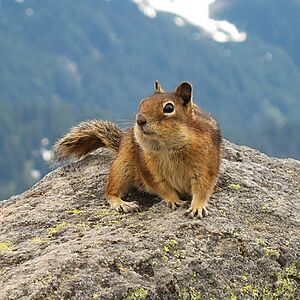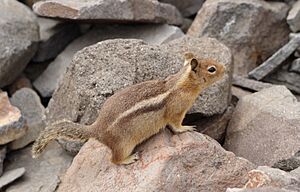Cascade golden-mantled ground squirrel facts for kids
Quick facts for kids Cascade golden-mantled ground squirrel |
|
|---|---|
 |
|
| Conservation status | |
| Scientific classification | |
| Genus: |
Callospermophilus
|
| Species: |
saturatus
|
 |
|
| Synonyms | |
|
Spermophilus saturatus |
|
The Cascade golden-mantled ground squirrel (Callospermophilus saturatus) is a type of rodent. It belongs to the squirrel family, Sciuridae. This squirrel is the largest of the three species in its group, Callospermophilus. You can find it living in the Cascade Mountains. These mountains are in British Columbia, Canada, and Washington, United States.
Contents
What Does It Look Like?
The Cascade golden-mantled ground squirrel is bigger than its close relatives. These are C. madrensis and C. lateralis. It has a reddish-brown color on its head and shoulders. This color continues down its body. These squirrels can grow to be at least 28.6 centimeters (about 11 inches) long.
Where Do These Squirrels Live?
C. saturatus lives in the northwestern United States. You can find them north of the Columbia River. They also live in British Columbia, Canada. There, they are found south of the Tulameen River and west of the Similkameen River.
These squirrels are separated from a similar species, S. lateralis, by the Columbia River. This separation likely caused them to become different species. This process is called allopatric speciation. It happens when groups of animals are separated and then change over time.
How Do Their Bodies Work?
When baby C. saturatus squirrels are born, their bodies are ectothermic. This means they cannot make their own body heat. They rely on their mother or their surroundings to stay warm.
Growing Up and Staying Warm
As they grow, their bodies slowly learn to make heat. This is called developing endothermy. They get bigger and grow more fur. By 36 days old, they can keep their bodies warm on their own. This is when they are called homeothermic. It's also around the time they leave their burrows for the first time.
Scientists tested if these squirrels could stay warm without food. Even when food and water were taken away for two days, older squirrels stayed warm. Smaller, younger squirrels did get cold. They had to be returned to their mother to warm up.
Energy and Movement
The amount of energy a mother squirrel uses each day changes slightly. It goes up about 10% if she has more babies. A normal litter size for this species is 3 to 5 offspring.
Scientists also studied how these squirrels move. They walk at about 0.21 meters per second. They can run much faster, at about 3.63 meters per second. Squirrels spend about 26.9% of their time above ground walking. They spend only 3.6% of their time running.
They run at their fastest speed to avoid predators. This is instead of running at a slower, more steady pace. On average, a C. saturatus squirrel moves about 5 kilometers (about 3 miles) each day. This includes 1.5 km walking and 3.3 km running. Moving this much uses a lot of energy. It adds about 29% more energy cost to their day.
What Do They Do?

Scientists have studied the alarm calls of ground squirrels. They found that C. saturatus has its own special way of calling out. Their calls are very clear and can be easily identified. This means that their calls can help tell them apart from other squirrel species. It's like how we use their looks or their genes to identify them.


